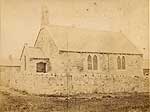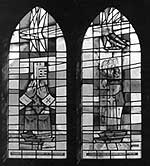

The Church & Chapel Doris Clarke The Sunday school used to have the treasure hunts up at the Towers, and they would have an afternoon up there. They could pick flowers with permission. I remember taking part in a concert up at the Hall, and Mrs Craster (Rosemary's grandmother) wanting to know who the child was singing something to do with 'daddy being in the army'. Billy Lumsden My father-in-law told me once, there was a fellow called Nightingale came here to preach, and he was one of these hell and damnation sort of preachers, and he got them all to throw away their pipes and baccy. They were hoying them on the rocks on their way from the chapel, and he says they were all going back with a candle and a jam jar looking for them at 12 o'clock at night. Fred Stephenson Rosemary Gibbs Many of the church fittings were given in memory of the Craster family and latterly members of the congregation. The east window in the church was given by Amy Craster in memory of her father, John, who died in 1895. The glass is a copy of part of a window designed by Joshua Reynolds in 1878 for the chapel of New College Oxford. It is thought that Amy Craster may have chosen this window as she was a friend of Caroline Rooke, who lived at 'Paradise' in Embleton. Caroline's father, George Rooke, was vicar of Embleton from 1830 to 1874 and her grandmother Lady Rooke (nee Harriet Sophia Burrand) was one of the ladies chosen by Sir Joshua to model 'justice' in the complete window in New College. Our window was re-leaded twenty years ago. The wooden pews were given in memory of Thomas's widow Charlotte Pulleine Craster (nee Roddam). The reading desk, designed and made by Robert (Mousie) Thompson in Yorkshire, was given by family and friends in memory of my grandmother Hilda Craster who played the organ for forty-seven years. She was a daughter of Canon Osborn, who came from Malvern to the parish of Embleton. Hilda married Thomas William Craster in 1897. The church silver was given in memory of my uncle Shafto Craster, who played the organ for many years, and also in memory of my mother Phyllis Carr-Ellison, who was Shafto's twin sister.
Canon Parke worshipped in our church after he had retired and left money for a beautiful stone cross to be erected on the roof of the church. The latest addition to the church, 1998, is the beautiful window designed by Leonard Evetts in memory of my mother Phyllis and her brother Shafto Craster. |


Home | The
Village | Occupations | Pictures |
About Us | Contact | Farming | Fishing | Kippering | Quarrying | Shops | Village
Life | Village
Childhood | Local Characters | Pastimes
Church & Chapel | Lifeboat | War
Years | Villager
Photos | Craster
Towers Photos |
Craster Village Photos | Farming
Photos | Fishing
Photos | Kippering
Photos | Quarrying
Photos
Site by Longstone Solutions
All site content © Craster Community Development Trust (CCDT)
2005.
 The
whole idea of coming to live in a village - if you don't join
in with anything, it means you are not mixing in at all. So first
of all when I lived with Granny Shell and then with Lena, they
were both church women. It was just a natural thing to get up
and go to church with Lena. I had already been confirmed in Gateshead.
The Church played a greater part in people's lives then.
The
whole idea of coming to live in a village - if you don't join
in with anything, it means you are not mixing in at all. So first
of all when I lived with Granny Shell and then with Lena, they
were both church women. It was just a natural thing to get up
and go to church with Lena. I had already been confirmed in Gateshead.
The Church played a greater part in people's lives then. Craster
Church was built in memory of my great-great grandfather Thomas
Wood Craster, who was the eldest son of John Wood of Beadnell
Hall. Thomas's mother and grandmother had both been Crasters.
Thomas inherited the estate from his uncle Shafto Craster who
died in 1836. Thomas changed his surname to Craster by Royal
Licence. Thomas Wood Craster died in 1867 and the church was
probably built a little later, about 1870, as a Sunday School
Hall; it then became a Mission Church serving the local community
and also the large number of fishermen who every summer followed
the herring shoals around the coast. Embleton Holy Trinity
Church remained the parish church for weddings baptisms and
funerals until 1978 when the Craster church was dedicated to
St Peter the Fisherman. After that baptisms and funerals were
allowed to take place in the church.
Craster
Church was built in memory of my great-great grandfather Thomas
Wood Craster, who was the eldest son of John Wood of Beadnell
Hall. Thomas's mother and grandmother had both been Crasters.
Thomas inherited the estate from his uncle Shafto Craster who
died in 1836. Thomas changed his surname to Craster by Royal
Licence. Thomas Wood Craster died in 1867 and the church was
probably built a little later, about 1870, as a Sunday School
Hall; it then became a Mission Church serving the local community
and also the large number of fishermen who every summer followed
the herring shoals around the coast. Embleton Holy Trinity
Church remained the parish church for weddings baptisms and
funerals until 1978 when the Craster church was dedicated to
St Peter the Fisherman. After that baptisms and funerals were
allowed to take place in the church. Our
organ was presented by Jimmy Bruce in memory of his wife Amy
(nee Robson) who died in 1986, and the font was given in memory
of Tom MacDonald who was the schoolmaster in Dunstan and then
Craster from 1955-1972. It was presented to the church by his
family in 1995.
Our
organ was presented by Jimmy Bruce in memory of his wife Amy
(nee Robson) who died in 1986, and the font was given in memory
of Tom MacDonald who was the schoolmaster in Dunstan and then
Craster from 1955-1972. It was presented to the church by his
family in 1995.